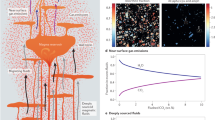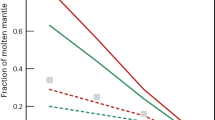Abstract
THE hypothesis of hot spots is central to many discussions about volcanism; it was first put forward by Wilson1 and has just been reemphasised by Morgan2 who proposes that a hot spot corresponds to the top of a plume raising from the deep mantle3. As a plate drifts above it, volcanic activity takes place, giving rise to a linear chain structure with a uniform progression of ages from the active head in a direction defined by the reversed absolute drift velocity of the plate.
This is a preview of subscription content, access via your institution
Access options
Subscribe to this journal
Receive 51 print issues and online access
$199.00 per year
only $3.90 per issue
Buy this article
- Purchase on Springer Link
- Instant access to full article PDF
Prices may be subject to local taxes which are calculated during checkout
Similar content being viewed by others
References
Wilson, J. T., Phil. Trans. R. Soc., 258, 145 (1965).
Morgan, J., Am. Ass. Petrol. Geol. Bull., 56, 203 (1972).
Deffeyes, K. S., Nature, 240, 539 (1972).
Wilson, J. T., and Burke, K., Trans. Am. geophys. Union, 54, 238–GP21 (1973).
Dewey, J. F., Trans. Am. geophys. Union, 54, 239–GP24 (1973).
Van Bemmelen, R. W., Tectonophysics, 18, 33 (1973).
Bellon, H., and Brousse, R., C.r. hebd. Séanc. Acad. Sci. Paris, 272, 3109 (1971).
Horn, P., Lippolt, H. J., and Todt, W., Eclog. Geol. Helv., 65/1, 121 (1972).
Frechen, J., and Lippolt, H. J., Eiszeit. Gegenw., 16, 5 (1965).
Bellon, H., Gillot, P. Y., and Nativel, P., Earth planet. Sci. Lett., (in the press).
Camus, G., Cantagrel, J. M., Taupinard, J., Vialette, Y., C.r. hebd. Seanc. Acad. Sci. Paris, 269, 2513 (1969).
Bellon, H., et al., C.r. hebd. Séanc. Acad. Sci. Paris, 274, 2409 (1972).
Brousse, R., in Magmatologie, du volcanisme neogène et quaternaire du Massif Central (Plein Air Service, Clermont, 1971).
Prévot, M., and Dalrymple, G. B., An. Geophys., 27, 423 (1971).
Bellon, H., Brousse, R., Mervoyer, B., and Blais, S., C.r. hebd. Séanc. Acad. Sci. Paris, 274, 2409 (1972).
Brousse, R., Daugas, J. P., Malacher, F., and Rudel, A., C.r. hebd. Séanc. Acad. Sci. Paris, 275, 2619 (1972).
Gillot, P. Y., Bellon, H., and Pantaloni, A., C.r. hebd. Séanc. Acad. Sci. Paris, 274, 2855 (1972).
Gillot, P. Y., thesis, Orsay (1974).
Ildefonse, J. P., Bellon, H., Pantaloni, A., and Philippet, J. C., Earth planet. Sci. Lett., 14, 249 (1972).
Cantagrel, J. M., and Mergoil, J., C.r. hebd. Séanc. Acad. Sci. Paris, 271, 760 (1970).
Berger, E., thesis, Orsay (1973).
Duncan, R. A., Petersen, N., and Hargraves, R., Nature, 239, 82 (1972).
Author information
Authors and Affiliations
Rights and permissions
About this article
Cite this article
FROIDEVAUX, C., BROUSSE, R. & BELLON, H. Hot spot in France?. Nature 248, 749–751 (1974). https://doi.org/10.1038/248749a0
Received:
Issue Date:
DOI: https://doi.org/10.1038/248749a0
This article is cited by
-
Identifying Potential Earthquake Sources in Continental Environments
Surveys in Geophysics (2022)
-
Melt inclusions in scoria and associated mantle xenoliths of Puy Beaunit Volcano, Chaîne des Puys, Massif Central, France
Contributions to Mineralogy and Petrology (2005)
-
Carbonic metamorphism, granulites and crustal growth
Nature (1980)
-
Refroidissement d’un système de dykes et d’une chambre magmatique sous-jacente
Bulletin Volcanologique (1976)
Comments
By submitting a comment you agree to abide by our Terms and Community Guidelines. If you find something abusive or that does not comply with our terms or guidelines please flag it as inappropriate.



